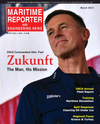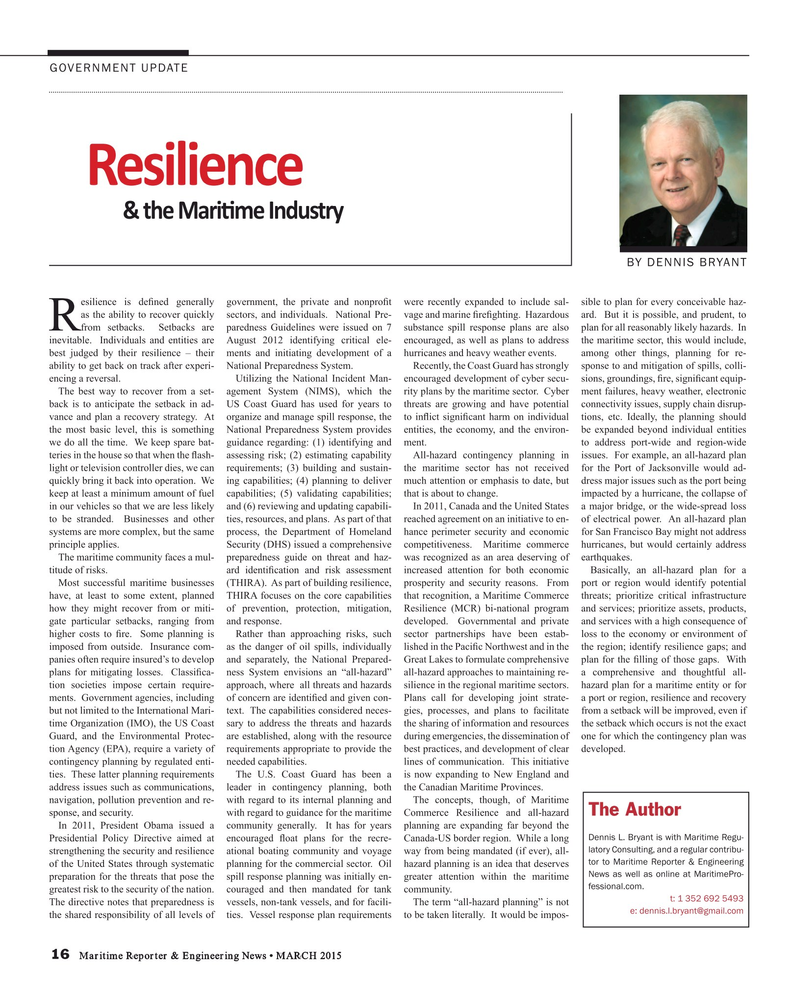
Page 16: of Maritime Reporter Magazine (March 2015)
U.S. Coast Guard Annual
Read this page in Pdf, Flash or Html5 edition of March 2015 Maritime Reporter Magazine
GOVERNMENT UPDATE Resilience & the Marit me Industry
BY DENNIS BRYANT esilience is de? ned generally government, the private and nonpro? t were recently expanded to include sal- sible to plan for every conceivable haz- as the ability to recover quickly sectors, and individuals. National Pre- vage and marine ? re? ghting. Hazardous ard. But it is possible, and prudent, to
Rfrom setbacks. Setbacks are paredness Guidelines were issued on 7 substance spill response plans are also plan for all reasonably likely hazards. In inevitable. Individuals and entities are August 2012 identifying critical ele- encouraged, as well as plans to address the maritime sector, this would include, best judged by their resilience – their ments and initiating development of a hurricanes and heavy weather events. among other things, planning for re- ability to get back on track after experi- National Preparedness System. Recently, the Coast Guard has strongly sponse to and mitigation of spills, colli- encing a reversal. Utilizing the National Incident Man- encouraged development of cyber secu- sions, groundings, ? re, signi? cant equip-
The best way to recover from a set- agement System (NIMS), which the rity plans by the maritime sector. Cyber ment failures, heavy weather, electronic back is to anticipate the setback in ad- US Coast Guard has used for years to threats are growing and have potential connectivity issues, supply chain disrup- vance and plan a recovery strategy. At organize and manage spill response, the to in? ict signi? cant harm on individual tions, etc. Ideally, the planning should the most basic level, this is something National Preparedness System provides entities, the economy, and the environ- be expanded beyond individual entities we do all the time. We keep spare bat- guidance regarding: (1) identifying and ment. to address port-wide and region-wide teries in the house so that when the ? ash- assessing risk; (2) estimating capability All-hazard contingency planning in issues. For example, an all-hazard plan light or television controller dies, we can requirements; (3) building and sustain- the maritime sector has not received for the Port of Jacksonville would ad- quickly bring it back into operation. We ing capabilities; (4) planning to deliver much attention or emphasis to date, but dress major issues such as the port being keep at least a minimum amount of fuel capabilities; (5) validating capabilities; that is about to change. impacted by a hurricane, the collapse of in our vehicles so that we are less likely and (6) reviewing and updating capabili- In 2011, Canada and the United States a major bridge, or the wide-spread loss to be stranded. Businesses and other ties, resources, and plans. As part of that reached agreement on an initiative to en- of electrical power. An all-hazard plan systems are more complex, but the same process, the Department of Homeland hance perimeter security and economic for San Francisco Bay might not address principle applies. Security (DHS) issued a comprehensive competitiveness. Maritime commerce hurricanes, but would certainly address
The maritime community faces a mul- preparedness guide on threat and haz- was recognized as an area deserving of earthquakes.
titude of risks. ard identi? cation and risk assessment increased attention for both economic Basically, an all-hazard plan for a
Most successful maritime businesses (THIRA). As part of building resilience, prosperity and security reasons. From port or region would identify potential have, at least to some extent, planned THIRA focuses on the core capabilities that recognition, a Maritime Commerce threats; prioritize critical infrastructure how they might recover from or miti- of prevention, protection, mitigation, Resilience (MCR) bi-national program and services; prioritize assets, products, gate particular setbacks, ranging from and response. developed. Governmental and private and services with a high consequence of higher costs to ? re. Some planning is Rather than approaching risks, such sector partnerships have been estab- loss to the economy or environment of imposed from outside. Insurance com- as the danger of oil spills, individually lished in the Paci? c Northwest and in the the region; identify resilience gaps; and panies often require insured’s to develop and separately, the National Prepared- Great Lakes to formulate comprehensive plan for the ? lling of those gaps. With plans for mitigating losses. Classi? ca- ness System envisions an “all-hazard” all-hazard approaches to maintaining re- a comprehensive and thoughtful all- tion societies impose certain require- approach, where all threats and hazards silience in the regional maritime sectors. hazard plan for a maritime entity or for ments. Government agencies, including of concern are identi? ed and given con- Plans call for developing joint strate- a port or region, resilience and recovery but not limited to the International Mari- text. The capabilities considered neces- gies, processes, and plans to facilitate from a setback will be improved, even if time Organization (IMO), the US Coast sary to address the threats and hazards the sharing of information and resources the setback which occurs is not the exact
Guard, and the Environmental Protec- are established, along with the resource during emergencies, the dissemination of one for which the contingency plan was tion Agency (EPA), require a variety of requirements appropriate to provide the best practices, and development of clear developed.
contingency planning by regulated enti- needed capabilities. lines of communication. This initiative ties. These latter planning requirements The U.S. Coast Guard has been a is now expanding to New England and address issues such as communications, leader in contingency planning, both the Canadian Maritime Provinces. navigation, pollution prevention and re- with regard to its internal planning and The concepts, though, of Maritime
The Author sponse, and security. with regard to guidance for the maritime Commerce Resilience and all-hazard
In 2011, President Obama issued a community generally. It has for years planning are expanding far beyond the
Dennis L. Bryant is with Maritime Regu-
Presidential Policy Directive aimed at encouraged ? oat plans for the recre- Canada-US border region. While a long latory Consulting, and a regular contribu- strengthening the security and resilience ational boating community and voyage way from being mandated (if ever), all- tor to Maritime Reporter & Engineering of the United States through systematic planning for the commercial sector. Oil hazard planning is an idea that deserves
News as well as online at MaritimePro- preparation for the threats that pose the spill response planning was initially en- greater attention within the maritime fessional.com. greatest risk to the security of the nation. couraged and then mandated for tank community.
t: 1 352 692 5493
The directive notes that preparedness is vessels, non-tank vessels, and for facili- The term “all-hazard planning” is not e: [email protected] the shared responsibility of all levels of ties. Vessel response plan requirements to be taken literally. It would be impos- 16 Maritime Reporter & Engineering News • MARCH 2015
MR #3 (10-17).indd 16 MR #3 (10-17).indd 16 3/3/2015 9:27:00 AM3/3/2015 9:27:00 AM

 15
15

 17
17
